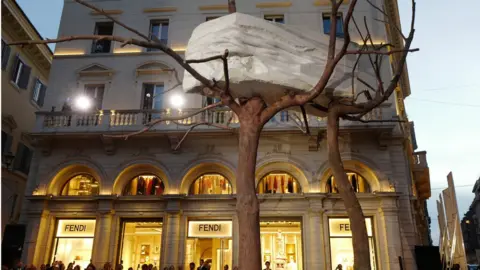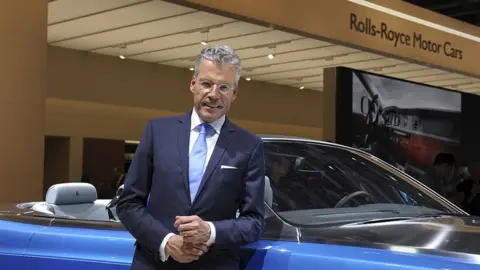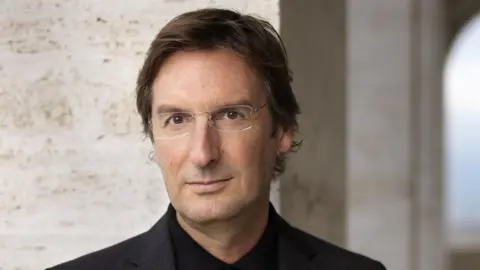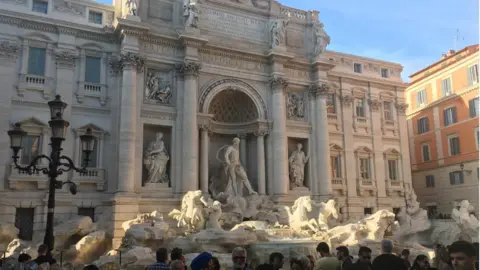How luxury firms are using art to attract customers
Luxury firms are often heavily involved in the art world, sponsoring individual artists or hosting exhibitions. But what is driving this interest?
If you had wandered into the Palazzo della Civilta Italiana in Rome earlier this year, you could have been forgiven for thinking you had stumbled into an art gallery.
For several months, the building's ground floor hosted an exhibition of works by the Italian artist Giuseppe Penone.
But the Palazzo is not a gallery. Since 2015, it has been the headquarters of Fendi, the fashion brand.
Fendi is far from the only luxury business backing artists and other cultural initiatives.
 Fendi
FendiHigh-end Swiss watchmaker Audemars Piguet has backed a series of artists over recent years and runs the annual Audemars Piguet Art Commission which includes a major annual commission each year.
Rolls-Royce also runs an art programme, while Fendi's parent company LVMH opened the Frank Gehry-designed Fondation Louis Vuitton in Paris in 2014.
LVMH says the move "epitomises the support for art, culture and heritage [the group] has been providing for nearly 25 years".
Why are enterprises like these getting so involved in cultural activities? Is it purely philanthropic or are there also commercial benefits?
In fact, it is for both these reasons and more, say bosses of luxury firms and observers of the industry.
 Getty Images
Getty Images"In this kind of segment you are not selling metal, you are selling dreams," says Torsten Muller-Otvos, chief executive officer of Rolls-Royce Motor Cars.
In the world of high-end luxury, "you need also to create a certain romanticism or romantic atmosphere around the brand," he says.
One way of doing this, Mr Muller-Otvos believes, lies in collaboration with artists.
The Rolls-Royce Art Programme, which has been running for several years, includes a series of events as well as commissions of new works. Artists who have participated include Yang Fudong, Jose Parla, Sudarshan Shetty, Angela Bulloch and Isaac Julien.
For Mr Muller-Otvos this activity offers benefits beyond strengthening the image of brand.
For one thing, he says, it has helped to deepen relationships with existing customers, including many who are art collectors, and also to attract new ones, who they might not otherwise reach.
 Kate Peters
Kate PetersHe also sees advantages on the production side of the equation.
The highly bespoke nature of the cars that Rolls-Royce makes means that the firm needs to employ artisans with various skills.
Artists involved with the Rolls-Royce scheme often visit the company's headquarters at Goodwood, Sussex, and spend time with workers there, swapping ideas and know-how.
"It's mutually beneficial for both parties," says Mr Muller-Otvos.
What do artists make of collaborations like these - and are they worried their creativity might be compromised by commercial considerations?
 Daniele Barraco
Daniele BarracoEarlier this year, Emirati artist Mohammed Kazem created a sculpture for the Rolls-Royce Art Programme, which has been on show in London and Abu Dhabi.
He says he had complete artistic freedom, and that his visits to the Goodwood HQ, and his interactions with the staff there, were very helpful to him in visualising the work he wanted to produce.
Nevertheless, many brands, particularly those in the luxury sector, like to retain tight control of their communications - isn't there a temptation for them to want to control the output of artists they work with?
If there is, it is one that should be resisted, says Fendi chief executive Pietro Beccari.
Artists must be free to work "without interference," he says. "Once you make the choice to choose one artist rather than the other, you have to go for it, otherwise you lose authenticity."
It is therefore vital, he adds, for companies to choose carefully artists who are "close to your sensibility" and the values of the brand.

In addition to backing artists such as Giuseppe Penone, Fendi has also funded projects such as the restoration of the Trevi fountain in Rome.
Pietro Beccari says initiatives like this can help the business in its push to identify itself more closely with Rome, "one of the most beautiful cities in the world, and which happens to be also a symbol of Dolce Vita [A life full of pleasure and indulgence] which is a lifestyle that we like to promote".
Does this mean that more traditional advertising is now less important?
No, says Mr Beccari. But today, luxury brands need to use many methods to get their core messages across, he says. "It's like a diamond with many facets, and every facet has a different side of the story."
Peter York, who has been an adviser to many luxury enterprises, says that businesses in this sector have little choice but to follow, in some form or another, the approach being taken by Fendi, Rolls-Royce and others.
He says: "The more that your brand is sold in luxury malls in China, the more concerned you are to reassure people who care about these things that you're 'the real thing', that you're associated with higher-level endeavours."
But there are dangers, Mr York warns. Entering into collaborations with artists, or backing other cultural ventures, must be approached with the same care and thought as that applied to a new product or range.
Be seen to be trying too hard, adds Mr York, and brands risk being seen as insecure, particularly by sophisticated customers.
